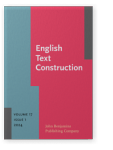Vol. 17:1 (2024) ► pp.–
The thematic organization of consumer safety instructions in English
This study investigates how the content of consumer safety instructions is organized in Themes and N-Rhemes and connected by thematic progressions. The Themes are chiefly directives or representations of the product and its usage. The goal of safety instructions, on the other hand, i.e. avoiding dangers and their negative outcomes, is mainly represented in the N-Rhemes. Thematic progressions are frequently linear, which reflects the expert/non-expert relationship between the writers and readers, or derived, which reflects the somewhat disjointedness of this text type. There are also many Rheme iterations connecting imperative clauses. In this respect the thematic organization of procedural texts differs significantly from texts where declarative clauses are predominant.
Article outline
- 1.Introduction
- 2.Theoretical background and earlier research
- 2.1Themes and Rhemes
- 2.2Thematic progressions
- 3.Material
- 4.Method
- 5.Results and discussion
- 5.1Themes
- 5.2N-Rhemes
- 5.3Progressions
- 6.Conclusion
- Notes
- Author queries
-
References
